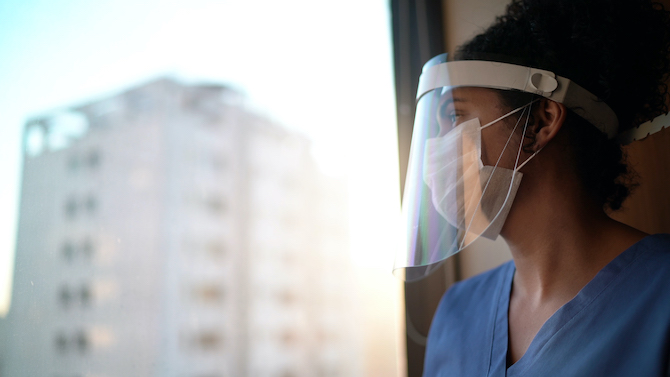The pandemic has ramped up everyone’s anxiety levels. But perhaps no group has experienced the enormity of stressors as heavily as our nation’s health care workers. They’ve seen the ravages or COVID-19 firsthand. Many caregivers are fearful about spreading the virus to family members. At the same time, they may be experiencing grief at the loss of patients or colleagues.
Under normal circumstances, providers could find solace in the company of their colleagues – at the hospital or when hanging out together after work. They’d find camaraderie working as part of a team and be rewarded by the smiles on the faces of patients and their families. But COVID-19 prevention measures, such as social distancing, PPE, and mask wearing, have made these kinds of meaningful exchanges things of the past. Many health care workers are struggling to stay connected, and for some, social distancing looks increasingly like social isolation.
What can leadership and staff do to help their care workers feel connected and valued during this pandemic? We’ll take a look at some novel solutions later in this post. But first, some numbers.
Pandemic Care Providers and Mental Health: The numbers are worrisome
Just how severe are the mental health implications for care providers? A recent study published in JAMA Psychiatry is telling. The authors surveyed 1,257 health workers at 34 hospitals in China, including those in the Wuhan province, the epicenter of the virus. Their findings showed that frontline workers reported the following:
- Distress (71.5%)
- Depression (50.4%)
- Anxiety (44.6%)
- Insomnia (34%)
These statistics are staggering, and they illustrate the magnitude of the mental health crisis that U.S. caregivers are up against. Health care workers’ challenges are further exacerbated by the social isolation created by quarantining, social distancing, and other COVID-19 prevention strategies. And in addition to caring for their patients, many have families who need their time and care at home. All too often, providers expend their engergy caring for others at the expense of their own well-being.
Social Isolation and Stress: Staying connected is critical
We know from studies like this one from the National Institues of Health that social isolation can easily descend into loneliness. Loneliness matters because it increases the risk for a whole host of mental health issues, including depression, anxiety, substance abuse, and suicide. And this is true during the best of times. During a pandemic, these problems may be compounded, especially among those working on the frontlines, who can add post-traumatic stress discorder and insomnia to their growing list of potential mental challenges.
Making matters worse, some health care workers feel stigmatized by society simply because of the nature of their work. This sort of marginalization only increases the sense of isolation and lack of human connection that health care workers continue to experience as the pandemic rages on.
Now more than ever, it’s critical that health care workers feel connected to their colleagues and patients, as well as valued and supported by their facilities. We’ve seen the massive shows of appreciation for health care workers from communities across the country. And that’s been pretty awesome. Less obvious, however, is an evolution within organizations to health physicians, nurses, and other hospital staff cope with social isolation. Such emerging strategies aim to create environments and opportunities that ease isolation, create connectivity, and boost employee resilience.
Environments Designed to Ease Isolation
Although we’ll never be able to entirely remove stress from the health care setting – it comes with the territory – changes in their physical environment may help providers start to feel human again.
- Create space to connect and communicate.
To do their job effectively, health care workers need to be able to communicate with their patients and colleagues. Body language comprises as much as 65% of all communication. However, masks and PPE obscure dialogue, smiles, and facial cues, as well as the ability to communicate ideas, feelings, and beliefs. To help workers better connect, try hosting virtual team-building events, such as Zoom coffee breaks, where they can exchange ideas, share stories, and simply see each other’s faces. - Take a break the natual way.
Research has shown that when we’re surrounded by plants, it can lower our physiological stress response, including our blood pressure and heart rate. Simply looking at gardens, trees, and other green spaces from break room windows can help alleviate stress. Many facilities are transforming break rooms by incorporating natural elements into “respite pods.” You can start by hanging artwork depicting natural images like trees in a forest or a pastoral countryside. Playing birdsongs and water sounds can also contribute to a calming space for workers to meditate, breathe, and connect with nature. - Make movement a moment.
Physical exercise is as good for your mind as it is for your body. It helps reduce stress and has benefits such as improving cognitive functioning and enhancing memory. Where gyms have safely reopened, organizations can show that they value their workers by providing memberships. Access to nearby walking trails lets providers get some fresh air and socialize during breaks. When that’s not possible, stairwells can be repurposed as destinations to catch up with colleagues, take a moment to press pause, or get a little exercise and clear your head.
Take Breaks to Boost Resilience
None of these environmental changes will do any good if workers aren’t taking breaks. We know that taking breaks can help improve productivity, diminish stress, and prevent burnout, yet health care workers may be reluctant to take them, especially in times of crisis like this pandemic. That’s why it’s so important that leadership promotes the benefits of taking breaks and getting enough rest. When caregivers feel valued and cared for by their facility – in body, mind, and spirit – they’ll perform better, be more resilient, and have greater longevity.
If you or any health care worker you know is struggling with mental health issues, or think you might be, the Centers for Disease Control and Prevention has put together a list of tips for how to copy with stress and build resilience during the pandemic.
Where do we go from here? You tell us!
We’d love to hear what you’re doing to combat social isolation in the era of social distancing. Have you come up with novel ways to let caregivers know you care? How common are respite rooms, and what does yours look like? Join us on Facebook at CCI Hub to share your stories and to keep this conversation going.



